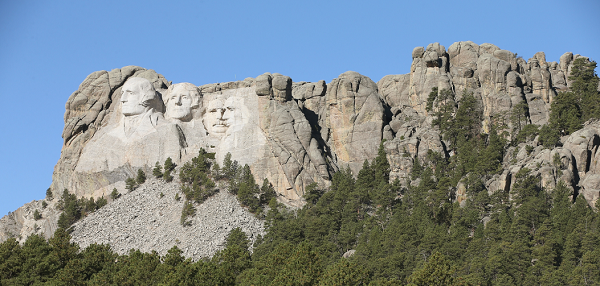Mount Rushmore 75th Anniversary: Facts, Pictures And History Of Iconic National Memorial In South Dakota

The U.S. is set to celebrate Mount Rushmore National Memorial's 75th anniversary Monday. Known as the Shrine of Democracy, the scenic South Dakota mountain emblazoned with the faces of four U.S. presidents is one of the biggest and most iconic attractions in America.
More than 2.1 million people trek through South Dakota’s Black Hills National Forest each year to get a glimpse of the iconic Mount Rushmore sculpture, which features 60-foot carvings of George Washington, Thomas Jefferson, Abraham Lincoln and Theodore Roosevelt.
After 75 years, Mount Rushmore is still driving tourism—by the millions. https://t.co/YeucYNx6hq Via @skift pic.twitter.com/a0g3ZoiJyv
— South Dakota Tourism (@southdakota) October 24, 2016
Mount Rushmore received its name in 1884 long before anyone thought to carve presidents’ faces into the side of the mountain. Charles E. Rushmore, a lawyer from New York, visited the Black Hills as part of a mining inspection when he stumbled upon the mountain – which had no name at the time – and deemed it Rushmore Peak. The name later changed to Rushmore Mountain before Mount Rushmore was settled on.
It wasn’t until the early 1920s when South Dakota’s state historian Duane Robinson proposed the idea to sculpt faces of historical heroes on the mountain’s southeastern region called the Needles, where giant pillars of natural granite stood. Danish-American sculptor Gutzon Borglum was hired for the job in 1924, and he suggested carving an image of Washington and Lincoln’s faces into the mountain in an effort to promote more national interest in the Black Hills. Over the years, Borglum would add Jefferson and Roosevelt’s faces to Mount Rushmore.
Although plenty of local Native Americans and environmentalists protested the project, Robinson still managed to raise enough funding for the sculpture with the help of Rapid City Mayor John Boland and Sen. Peter Norbeck. Borglum won the support of President Calvin Coolidge while the president toured the Black Hills during a summer vacation. On Aug. 10, 1927, Coolidge gave the first official dedication speech at Mount Rushmore announcing the sculpture to come. Just before Coolidge’s presidency ended, he signed legislation approving $250,000 in federal funds for the Mount Rushmore sculpture and appointed a Mount Rushmore National Memorial Commission to oversee the project’s completion.
Production started with Washington’s face in October 1927. Using Borglum’s then-new method of dynamite and pneumatic hammers to crush the rock, some 400 workers were able to remove more than 450,000 tons of rock from Mount Rushmore. Despite the dangerous and vigorous work, not one person died during production. The final dedication ceremony of the completed Mount Rushmore was held Oct. 31, 1941 — just a few months before Borglum died in March of that year, leaving his son Lincoln Borglum to finish the final details.
© Copyright IBTimes 2024. All rights reserved.






















